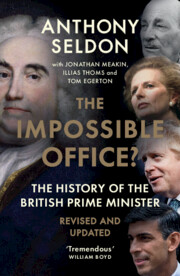Book contents
- The Impossible Office?
- Works by Anthony Seldon
- The Impossible Office?
- Copyright page
- Dedication
- Contents
- Preface
- Chapter 1 The 300th Anniversary Bookend Prime Ministers
- Chapter 2 A Country Transformed, 1721–2024
- Chapter 3 The Liminal Premiership
- Chapter 4 The Transformational Prime Ministers, 1806–2024
- Chapter 5 The Powers and Resources of the Prime Minister, 1721–2024
- Chapter 6 The Constraints on the Prime Minister, 1721–2024
- Chapter 7 The Eclipse of the Monarchy, 1660–2024
- Chapter 8 The Rise and Fall of the Foreign Secretary, 1782–2024
- Chapter 9 The Rise, and Rise, of the Chancellor of the Exchequer, 1660–2024
- Chapter 10 The Impossible Office?
- Acknowledgments to the First Edition
- Notes
- Bibliography
- Index
Chapter 3 - The Liminal Premiership
From the Saxons to 1806
Published online by Cambridge University Press: 14 March 2024
- The Impossible Office?
- Works by Anthony Seldon
- The Impossible Office?
- Copyright page
- Dedication
- Contents
- Preface
- Chapter 1 The 300th Anniversary Bookend Prime Ministers
- Chapter 2 A Country Transformed, 1721–2024
- Chapter 3 The Liminal Premiership
- Chapter 4 The Transformational Prime Ministers, 1806–2024
- Chapter 5 The Powers and Resources of the Prime Minister, 1721–2024
- Chapter 6 The Constraints on the Prime Minister, 1721–2024
- Chapter 7 The Eclipse of the Monarchy, 1660–2024
- Chapter 8 The Rise and Fall of the Foreign Secretary, 1782–2024
- Chapter 9 The Rise, and Rise, of the Chancellor of the Exchequer, 1660–2024
- Chapter 10 The Impossible Office?
- Acknowledgments to the First Edition
- Notes
- Bibliography
- Index
Summary
This chapter offers a historical power analysis from the Saxons to the end of Pitt the Younger’s premiership. In the liminal premiership, the ‘key’ minister/advisor behind the monarch, or Oliver Cromwell during the republic, had serious power, but cannot be considered a prime minister as their power was wholly dependent on the monarch, and the complex machinations of court politics. The important innovation is how the role of ‘lead’ minister developed, with the monarch’s agreement, into the more independent ‘prime’ minister. We contend that only with Robert Walpole’s accession to the office did the power of prime minister become apparent, the primary reason being the monarch’s (George I) reliance on Walpole to control Parliament for spending and the protection of the monarch’s power. However, it was only with Pitt the Younger’s premiership, which truly established more formal parts of the office – particularly the Treasury, the state/economy and the Cabinet – that we see the beginnings of the modern office we know today.
- Type
- Chapter
- Information
- The Impossible Office?The History of the British Prime Minister - Revised and Updated, pp. 69 - 111Publisher: Cambridge University PressPrint publication year: 2024

